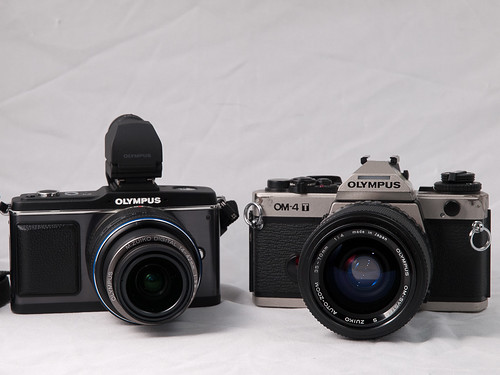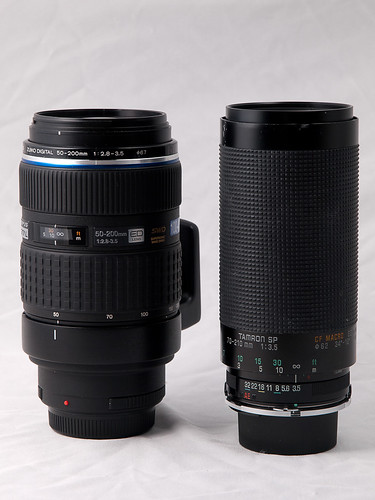A brief look at old zooms
I wrote previously about single-focal length lenses (primes) and how they'd gone from ubiquitous to specialized, while at the same time zooms had changed places with them, going from specialized to ubiquitous. I still have two zooms in my collection from the period I shot film; the Tamron 70-210mm f/3.5 BBAR and the S Zuiko 35-70mm f/4 zoom.
Sitting side-by-side, the OM-4 T and the E-P2 aren't that much different in practical size. Add the VF-2 electronic viewfinder to the E-P2, and the E-P2 stands taller than the OM-4. But again, it's nothing to make a fuss over.
Looking down from above, it appears that the E-P2 is thinner than the OM-4, but that's due to the black top plate of the E-P2. The actual depth of the E-P2 is the silver metal secondary plate on which the black top plate sits. For all practical purposes the depth of the two bodies is the same, except at the mirror box on the OM-4 T; the E-P2 is mirrorless, and this much shallower depth allows the E-P2 to mount and use the S Zuiko with a simple mechanical adapter.
Where the two cameras noticeably differ in size is their lenses. The M.Zuiko 14-42mm (28-82mm equivalent) f/4-5.6 is far smaller and lighter than the S Zuiko 35-70mm f/4 lens. The S Zuiko has the advantage of being a fixed aperture through its zoom range, and in spite of its so-called slow maximum aperture, it's remarkably bright and easy to focus with. The M.Zuiko has a wider zoom range, but the 35-70mm covers the practical work-a-day range of medium wide-angle to short telephoto.
What we have next is a comparison between the Tamron on the right and the ZD 50-200mm on the left. The ZD is bigger and heavier than the Tamron, but it covers a 4:1 zoom range vs the Tamron's 3:1 range. What's more the ZD is dust- and moisture-proof, where the Tamron is not. Finally, the ZD has autofocus, while the Tamron doesn't.
Optically, the ZD is better than the Tarmron, but then you're comparing a lens manufactured in the mid-1980's (the Tamron) with a lens that's 20 years its junior; you'd expect a little progress. Regardless, with the right kind of film, subject, and lighting, the Tamron produces results that satisfy every bit as much as the ZD on an Olympus 4/3rds body.
Over the years I've had many wonderful opportunities to own and work with a number of superb camera systems, both film and digital. There is no such thing as a 'bad' camera. It's purely a matter of personal taste, technique, and capability which camera you decide to own and use.
Sitting side-by-side, the OM-4 T and the E-P2 aren't that much different in practical size. Add the VF-2 electronic viewfinder to the E-P2, and the E-P2 stands taller than the OM-4. But again, it's nothing to make a fuss over.
Looking down from above, it appears that the E-P2 is thinner than the OM-4, but that's due to the black top plate of the E-P2. The actual depth of the E-P2 is the silver metal secondary plate on which the black top plate sits. For all practical purposes the depth of the two bodies is the same, except at the mirror box on the OM-4 T; the E-P2 is mirrorless, and this much shallower depth allows the E-P2 to mount and use the S Zuiko with a simple mechanical adapter.
Where the two cameras noticeably differ in size is their lenses. The M.Zuiko 14-42mm (28-82mm equivalent) f/4-5.6 is far smaller and lighter than the S Zuiko 35-70mm f/4 lens. The S Zuiko has the advantage of being a fixed aperture through its zoom range, and in spite of its so-called slow maximum aperture, it's remarkably bright and easy to focus with. The M.Zuiko has a wider zoom range, but the 35-70mm covers the practical work-a-day range of medium wide-angle to short telephoto.
What we have next is a comparison between the Tamron on the right and the ZD 50-200mm on the left. The ZD is bigger and heavier than the Tamron, but it covers a 4:1 zoom range vs the Tamron's 3:1 range. What's more the ZD is dust- and moisture-proof, where the Tamron is not. Finally, the ZD has autofocus, while the Tamron doesn't.
Optically, the ZD is better than the Tarmron, but then you're comparing a lens manufactured in the mid-1980's (the Tamron) with a lens that's 20 years its junior; you'd expect a little progress. Regardless, with the right kind of film, subject, and lighting, the Tamron produces results that satisfy every bit as much as the ZD on an Olympus 4/3rds body.
Over the years I've had many wonderful opportunities to own and work with a number of superb camera systems, both film and digital. There is no such thing as a 'bad' camera. It's purely a matter of personal taste, technique, and capability which camera you decide to own and use.




nice comparison. I noted that my OM-10 was about the same size as my Panasonic G1 in a blog post of mine a while back too.
ReplyDeleteEssentially to keep the cameras the same size (digital vs film) it seems that they've had to go to much smaller capture areas.
Seeing the size of the Sony NEX cameras it will be interesting to see if we get smaller digitals in the future which are full frame.
that is of course if anyone still wants full frame